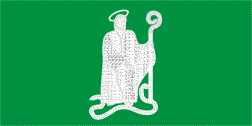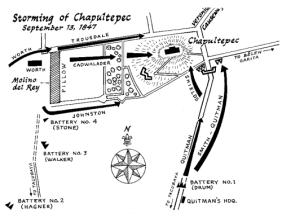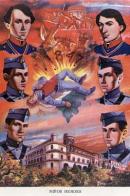

By Roy Cook
The
war between the United States and Mexico had two basic causes.
1. First,
the desire of the U.S. to expand across the North American continent, the
policy of Manifest Destiny, to the Pacific Ocean caused conflict with all
of the U.S. neighbors; from the British in Canada and Oregon to the Mexicans
in the southwest and, of course, with the Native Americans, many on U.S. treaty secured lands.
2. The
second basic cause of the war with Mexico was the Texas War of Independence
and the subsequent annexation of that area to the United States.
After the beginning of hostilities, the
U.S. military reported to the President and it became apparent to the Polk
Administration that only a complete battlefield victory would end the war.
Continued fighting in the dry deserts of northern Mexico convinced the United
States that an overland expedition to capture of the enemy capital, Mexico
City, would be hazardous and difficult. To this end, General Winfield Scott
proposed what would become the largest amphibious landing in history, (at
that time), and a campaign to seize the capital of Mexico. The Marine Corps
still recognizes this landing in the first line of the Corps' hymn: From the Halls of Montezuma.
One
interesting aspect of the war involves the fate of U.S. Army deserters of
Irish origin who joined the Mexican Army as the Batallón San Patricio (Saint
Patrick's Battalion). This group of Catholic Irish immigrants rebelled at
the abusive treatment by Protestant, American-born officers and at the treatment
of the Catholic Mexican population by the U.S. Army. At this time in American
history, Catholics were an ill-treated minority, and the Irish were an unwanted
ethnic group in the United States. In September 1847, the U.S. Army hanged
sixteen surviving members of the San Patricios as traitors. To this day, they
are considered heroes in Mexico.
 The story of
this famed group begins with the founder and chief conspirator, John Riley,
a Galway native born in 1817. Riley deserted from the British army while stationed
in Canada and went to Michigan, where he later enlisted in the US Army in
1845. He was able to defect to the Mexican Army when his commander granted
him permission to cross into Mexico to attend mass. It was there, in Matamoros,
Riley joined the Mexican Army as a lieutenant, which resulted in his pay rising
from seven dollars per month to 57 dollars per month. While desertion from
the US armed forces was punishable by death, Riley was not deterred in capitalizing
on the dis-satisfaction of many Irish-born US soldiers with their adopted
country. Aided by his second-in-command, Patrick Dalton, who was from the
parish of Tirawley, near Ballina, County Mayo, Riley at first was successful
in persuading 48 Irishmen to defect, and these men made up the original Saint
Patrick's Battalion. In addition to more Irishmen joining, they welcomed other
foreign-born US deserters, as well as American-born deserters. Also, some
Irish-born civilian residents of Mexico were persuaded to join the struggle.
Even when the number of San Patricios rose to more than 200, Irish-born members
still represented nearly 50 per cent.
The story of
this famed group begins with the founder and chief conspirator, John Riley,
a Galway native born in 1817. Riley deserted from the British army while stationed
in Canada and went to Michigan, where he later enlisted in the US Army in
1845. He was able to defect to the Mexican Army when his commander granted
him permission to cross into Mexico to attend mass. It was there, in Matamoros,
Riley joined the Mexican Army as a lieutenant, which resulted in his pay rising
from seven dollars per month to 57 dollars per month. While desertion from
the US armed forces was punishable by death, Riley was not deterred in capitalizing
on the dis-satisfaction of many Irish-born US soldiers with their adopted
country. Aided by his second-in-command, Patrick Dalton, who was from the
parish of Tirawley, near Ballina, County Mayo, Riley at first was successful
in persuading 48 Irishmen to defect, and these men made up the original Saint
Patrick's Battalion. In addition to more Irishmen joining, they welcomed other
foreign-born US deserters, as well as American-born deserters. Also, some
Irish-born civilian residents of Mexico were persuaded to join the struggle.
Even when the number of San Patricios rose to more than 200, Irish-born members
still represented nearly 50 per cent.
Looking
back, to the motivation for the policy of Manifest Destiny, we need to examine
President Jefferson's acquisition of the right to treat with the Indian Nations
for land in Louisiana Territory in 1803, Americans illegally migrated westward
in ever increasing numbers, very often into lands not belonging to the United
States. By the time President Polk came to office in 1845, this idea, based
on racist principals called "Manifest Destiny", had taken root among the American
people, and President Polk was a firm believer in the idea of expansion. The
belief that the U.S. basically had a Euro-centered God-given right to occupy
and "civilize" the whole continent gained favor as more and more Americans
invaded the western lands. The fact that most of those areas already had Tribal
people living upon them was usually ignored, with the attitude that democratic
English-speaking America, with its high ideals and Protestant Christian ethics,
would do a better job of running things than the Native Americans or Spanish-speaking
Catholic Mexicans.
Manifest
Destiny did not necessarily call for violent expansion if the land can be
bought cheap. In both 1835 and 1845, the United States offered to purchase
California from Mexico, for $5 million and $25 million, respectively. The
Mexican government refused the opportunity to sell half of its country to
Mexico's most dangerous neighbor. Many
Americans opposed what they called "Mister Polk's War." Whig Party members
and abolitionists in the North believed that slave-owners and Southerners
in Polk's administration had planned the war. They believed the South wanted
to win Mexican territory for the purpose of spreading and strengthening slavery.
This opposition troubled President Polk. But he did not think the war would
last long. He thought the US could quickly force Mexico to sell him the territory
he wanted.
Polk
secretly sent a representative to former Mexican dictator Santa Ana, who was
living in exile in Cuba. Polk's representative said the United States wanted
to buy California and some other Mexican territory. Santa Ana said he would
agree to the sale, if the United States would help him return to power. President
Polk ordered the US Navy to let Santa Ana return to Mexico. American ships
that blocked the port of Vera Cruz permitted the Mexican dictator to land
there. Once Santa Ana returned, he failed to honor his promises to Polk. He
refused to end the war and sell California. Instead, Santa Ana organized an
army to fight the United States.
Not
all American westward migration was unwelcome. In the 1820's and 1830's, Mexico,
newly independent from Spain, needed settlers in the under-populated northern
parts of the country. An invitation was issued for people who would take an
oath of allegiance to Mexico and convert to Catholicism, the official religion.
Thousands of Americans took up the offer and moved, often with slaves, to
the Mexican province of Tejas (texas). Soon however, many of the new "Texicans"
or "Texians" were unhappy with the way the government in Mexico City tried
to run the province. In 1835, the Tejanos revolted, and after several bloody
battles, the Mexican President, Santa Anna, was forced to sign the Treaty
of Velasco in 1836 This treaty
gave Tejas (texas) its independence, but many Mexicans refused to accept the
legality of this document, as Santa Anna was a prisoner of the Tejanos at
the time. The Republic of Tejas (texas) and Mexico continued to engage in
border fights and many people in the United States openly sympathized with
the U.S.-born Texans in this conflict. As a result of the savage frontier
fighting, the American public developed a very negative stereotype against
the Mexican people and government. Partly due to the continued hostilities
with Mexico, Texas decided to join with the United States, and on July 4,
1845, the annexation gained approval from the U.S. Congress.
Official Military campaign accounts: The
"Army of Observation" commanded by General Zachary Taylor was deployed to
Corpus Christi, at the mouth of the Nueces River, to protect newly annexed
Texas in the summer of 1845. The force consisted of 5 regiments of infantry,
1 regiment of dragoons, and 16 companies of artillery. After the beginning of hostilities, the
U.S. military embarked on a three-pronged strategy designed to seize control
of northern Mexico and force an early peace. Two American armies moved south
from Texas, while a third force under Colonel Stephen Kearny travelled west
to Sante Fe, New Mexico and then to California. In a series of battles at
Palo Alto and Resaca de Palma (near current-day Brownsville, Texas), the army
of General Zachary Taylor defeated the Mexican forces and began to move south
after inflicting over a thousand casualties. In July and August of 1846, the
United States Navy seized Monterey and Los Angeles in California. In September,
1846, Taylor's army fought General Ampudia's forces for control of the northern
Mexican city of Monterey in a bloody three-day battle. Following the capture
of the city by the Americans, a temporary truce ensued which enabled both
armies to recover from the exhausting Battle of Monterey. During this time,
former President Santa Anna returned to Mexico from exile and raised and trained
a new army of over 20,000 men to oppose the invaders. Despite the losses of
huge tracts of land, and defeat in several major battles, the Mexican government
refused to make peace.
On
March 9, 1847, General Scott landed with an army of 12,000 men on the beaches
near Veracruz, Mexico's most important eastern port city. From this point,
from March to August, Scott and Santa Anna fought a series of bloody, hard-fought
battles from the coast inland toward Mexico City.
Churubusco, 20 August 1847.
Santa Anna promptly made another stand on Churubusco where he suffered a disastrous
defeat in which his total losses for the day "killed, wounded, and especially
deserters" were probably as high as 10,000. Scott estimated the Mexican
losses at 4,297 killed and wounded, and he took 2,637 prisoners. Of 8,497 Americans
engaged in the almost continuous battles of Contreras and Churubusco, 131 were
killed, 865 wounded, and about 40 missing.
 Scott
proposed an armistice to discuss peace terms. Santa Anna quickly agreed; but
after two weeks of fruitless negotiations it became apparent that the Mexicans
were using the armistice merely for a breathing spell. On 6 September Scott
broke off discussions and prepared to assault the capital. To do so, it was
necessary to take the citadel of Chapultepec, a massive stone fortress on
top of a hill about a mile outside the city proper. Defending Mexico City
were from 18,000 to 20,000 troops, and the Mexicans were confident of victory,
since it was known that Scott had barely 8,000 men and was far from his base
of supply.
Scott
proposed an armistice to discuss peace terms. Santa Anna quickly agreed; but
after two weeks of fruitless negotiations it became apparent that the Mexicans
were using the armistice merely for a breathing spell. On 6 September Scott
broke off discussions and prepared to assault the capital. To do so, it was
necessary to take the citadel of Chapultepec, a massive stone fortress on
top of a hill about a mile outside the city proper. Defending Mexico City
were from 18,000 to 20,000 troops, and the Mexicans were confident of victory,
since it was known that Scott had barely 8,000 men and was far from his base
of supply.
Molino del Rey, 8 September 1847.
On 8 September 1847, the Americans launched an assault on Molino del Rey, the
most important outwork of Chapultepec. It was taken after a bloody fight, in
which the Mexicans suffered an estimated 2,000 casualties and lost 700 as prisoners,
while perhaps as many as 2,000 deserted. The small American force had sustained
comparatively serious losses "124 killed and 582 wounded" but they
doggedly continued their attack on Chapultepec, which finally fell on
13 September 1847. American losses were 138 killed and 673 wounded during
the siege of the fortress. Mexican losses in killed, wounded, and captured totaled
about 1,800. The fall of the citadel brought Mexican resistance practically
to an end. Authorities in Mexico City sent out a white flag on 14 September
1847. Santa Anna abdicated the Presidency, and the last remnant of his army,
about 1,500 volunteers, was completely defeated a few days later while attempting
to capture an American supply train.
On 2 February 1848, the Treaty of
Guadalupe Hidalgo was signed, ratified in the U.S. Senate on 10 March 1848,
by the Mexican Congress in May. The
treaty called for the annexation of the northern portions of Mexico to the
United States. On 1 August
1848 the last American soldier departed for home.
In
return, the U.S. agreed to pay $15 million to Mexico as compensation for the
seized territory. This "seized Mexican territory" is the most controversial
issue in the Southwest history. Almost never delineated is the actual territory
controlled and not just claimed by Mexico or previously by Spain.
The
bravery of the individual Mexican soldier goes a long way in explaining the
difficulty the U.S. had in conducting the war. Mexican military leadership
was often lacking, at least when compared to the American leadership. And
in many of the battles, the superior cannon of the U.S. artillery divisions
and the innovative tactics of their officers turned the tide against the Mexicans.
The war cost the United States over $100 million, and ended the lives of 13,780
U.S. military personnel. America had defeated its weaker and somewhat disorganized
southern neighbor, but not without paying a terrible price.
1. Despite
early popularity at home, the war was marked by the growth of a loud anti-war
movement that included such noted Americans as Ralph Waldo Emerson, former
president John Quincy Adams and Henry David Thoreau. The center of anti-war
sentiment gravitated around New England, and was directly connected to the
movement to abolish slavery. Texas became a slave state upon entry into the
Union.
2. While it is
widely perceived in Mexico that the San Patricios defected solely on the issue
of religion, this myth is examined in a later chapter of Robert Miller's book:
Shamrock and Sword, entitled "Why they Defected". The fact that
there was rampant anti-Catholic bigotry in the US at that time does not play
as great a role in the formation of the unit as is believed in Mexico. Miller
states that the religious bond was not a main reason why many defected. The
attractive offer of high pay in the Mexican Army and the promise of land grants
to defectors after the war outweighed the fraternal bond over religion, according
to Miller.
A main reason
for their hero status in Mexico is derived from their exemplary performance
in the battlefield. The San Patricios ultimately suffered severe casualties
at the famous battle at Churubusco, which is considered the Waterloo for the
Mexican Army in this war. Mexican President Antonio Lopez Santa Anna, who
also commanded the armed forces, stated afterwards that if he had commanded
a few hundred more men like the San Patricios, Mexico would have won that
ill-famed battle.
Each San Patricio
soldier who deserted from the US side was interned after the war in Mexico
and subsequently given an individual court-martial trial. Many of the Irish
were set free, but some paid the ultimate price. Roughly half of the San Patricio
defectors who were executed by the US for desertion were Irish. Those Irish
who were released by American authorities did not return to the US; some stayed
in Mexico while most returned to Ireland, including John Riley who, surprisingly,
was spared execution.
Furthermore,
Miller makes it clear that the Irish deserters of the Saint Patrick's Battalion
were in no way representative of the Irish-born soldiers who made up one-fourth
of all enlisted men in the US Army during the US-Mexican War. There were seventeen
totally Irish companies who saw action in this war; many were highly decorated
units such as the Emmet Guards from Albany, New York; the Jasper Greens of Savannah,
Georgia; the Mobile Volunteers of Alabama; the Pittsburgh Hibernian Greens.
 In 1959, the Mexican government dedicated
a commemorative plaque to the San Patricios across from San Jacinto Plaza
in the Mexico City suburb of San Angel; it lists the names of all members
of the battalion who lost their lives fighting for Mexico, either in battle
or by execution. There are ceremonies there twice a year, on September 12,
this is the anniversary of the executions, and on Saint Patric's Day. A major
celebration was held there in 1983, when the Mexican government authorized
a special commemorative medallion honoring the San Patricios.
In 1959, the Mexican government dedicated
a commemorative plaque to the San Patricios across from San Jacinto Plaza
in the Mexico City suburb of San Angel; it lists the names of all members
of the battalion who lost their lives fighting for Mexico, either in battle
or by execution. There are ceremonies there twice a year, on September 12,
this is the anniversary of the executions, and on Saint Patric's Day. A major
celebration was held there in 1983, when the Mexican government authorized
a special commemorative medallion honoring the San Patricios.
The Infantry flag made by the nuns at San
Luis Potosi is described as "The banner is of green silk, and on one side
is a harp, surmounted by the Mexican coat of arns, with a scroll on which
is painted 'Lebertad por Republica Mexicana". Underneath the harp is the motto
"Erin Go Bragh'. (Ireland Forever) On the other side is a painting made to
represent St. Patrick, his left hand a key and in his right a crook or staff
resting upon a serpent.
This is the flag captured at Churubusco
by the 14th US Infantry and later apparently taken to West Point and placed
in the chapel. But, it did not survive because when President Truman returned
the captured Mexican War flags it was not returned. The chapel was replaced
sometime in the 1930's and by then the flag seems to have vanished.
3.
In Mexico, a special day is remembered to celebrate the bravery of the teenaged
military cadets at the military academy at Chapultepec Castle, which was attacked
by Scott's army on September 13, 1847. "Dia de Los Niños Heroes de Chapultepec"
(day of the boy heroes of Chapultepec), is commemorated every year on the
anniversary of the battle.
 Seated
high on a hill, Chapultepec Castle had once been the resort of Aztec princes,
hence its fame as the Halls of Montezuma. Since 1833, it had served as Mexico's
military academy, and the cadets now fought side by side with seasoned soldiers
in heroic defense of their castle and country. Six of the youths died, one
clutching the Mexican flag to keep it from American hands. For their valor,
they have been honored in annual celebrations as Los Niños Héroes. Ordered to retreat by their Commandant,
these young cadets joined the fight- the boy heroes who are honored every
year are the four teenaged cadets (Francisco Marquez, the youngest, was thirteen
years old!) and their lieutenant squadron leader, Juan de la Barrera, (the
oldest, age 20), who lost their lives in that battle.
Seated
high on a hill, Chapultepec Castle had once been the resort of Aztec princes,
hence its fame as the Halls of Montezuma. Since 1833, it had served as Mexico's
military academy, and the cadets now fought side by side with seasoned soldiers
in heroic defense of their castle and country. Six of the youths died, one
clutching the Mexican flag to keep it from American hands. For their valor,
they have been honored in annual celebrations as Los Niños Héroes. Ordered to retreat by their Commandant,
these young cadets joined the fight- the boy heroes who are honored every
year are the four teenaged cadets (Francisco Marquez, the youngest, was thirteen
years old!) and their lieutenant squadron leader, Juan de la Barrera, (the
oldest, age 20), who lost their lives in that battle.
Notes and sources:
1.
Kohn, George C. Dictionary of Wars. New York: Facts On File
Publications. 1986.
2.
Eisenhower, John S.D. So Far From God: The U.S. War With Mexico 1846-1848.
New York: Anchor Books, Doubleday. 1989.
3.
Winders, Richard Bruce. Mr. Polk's Army. Texas A&M, 1997.
4.
Frazier, Donald S., ed. The U.S. and Mexico at War: Nineteenth Century
Expansionism and Conflict. Macmillan Library Reference, 1998.
5.
Lee, R. "The History Guy: The Mexican-American War"
6.
Miller, Robert R: Shamrock &
Sword